LG 360 VR Review
LG 360 VR
You'd be better of with Google Cardboard
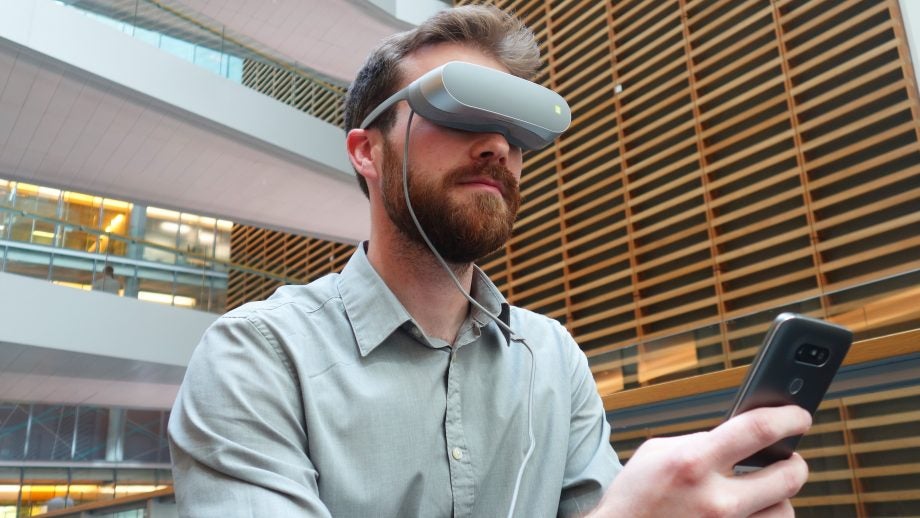
Verdict
Pros
- Good gift for someone you dislike
Cons
- Design is poor
- Works poorly
- Uncomfortable
- Expensive
- No apps
Key Specifications
- Review Price: £200.00
- 1.88-inch IPS LCD screen
- 920 x 720 pixels-per-eye resolution
- 639ppi
- Adjustable lenses
- 80-degree horizontal field-of-view
- USB Type-C connector
- 3.5mm headphone jack
- 6-axis (gyro and accelerometer) proximity sensor
- 116g
What is the LG 360 VR?
The 360 VR is LG’s attempt to use virtual reality to promote its new phone, the LG G5. This VR headset made its appearance alongside a number of other G5-compatible “Friends” at the phone’s launch earlier this year. Unlike the Samsung Gear VR, which uses your phone as its screen, the 360 VR has a built-in display, with unit plugging directly into the G5 for power. You then use the handset’s screen to control the headset using taps and swipes.
There’s no doubt that virtual reality will be one of the biggest, if not the biggest, technologies of 2016. And with the Oculus Rift and HTC Vive costing around £600, there’s certainly room in the market for some entry-level headsets.
However, at around £200 (current UK prices range from £190 to £260; these may drop when the headset becomes widely available), the 360 VR is twice as expensive as Samsung’s alternative, plus it requires you to buy a LG G5 smartphone. In other words, the device had better offer a pretty impressive VR experience if it’s going to justify its existence beyond being a marketing tool for LG’s modular phone.
Unfortunately, it isn’t up to the task. If you’re yet to try virtual reality then you may be moderately taken with LG’s headset at first. That is, before the numerous bugs and issues start to wear you down. If you’ve already experienced VR, however, then you’re going to be disappointed from the get go.
Video – Trusted Explains: What is VR?
LG 360 VR – Design
The 360 VR doesn’t look like any other headset on the market – and in this instance, this isn’t a good thing. Admittedly, it’s difficult – maybe impossible even – to make anyone look cool while wearing a VR headset. But with the 360 VR it appears that LG’s engineers have made no attempt to overcome this issue.
The headset sports a look akin to what folk in the 1980s envisaged a futuristic product would look like. It looks like a low-cost, NHS-prescribed item for correcting poor vision.
Related: What is virtual reality?
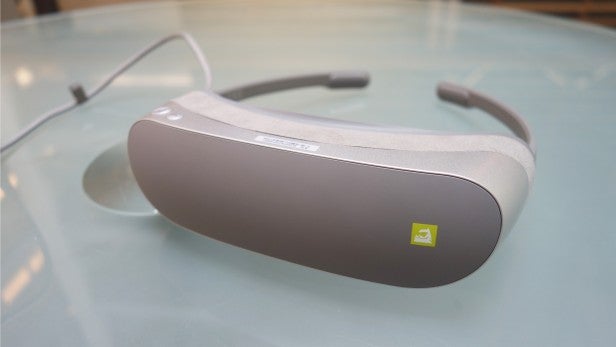
The 360 VR’s arms are made from a flexible plastic similar to the uncomfortable 3D glasses you get at the cinema. The bulk of the headset is grey plastic, and features a flexible fabric light shield (more on this later) that’s removable. The whole unit weighs a piddle 116g. In comparison, Samsung’s Gear VR weighs 310g. The weight loss is mainly due to the fact you don’t have to dock your phone into the headset.
On the plus side then, LG’s minimalist approach means the 360 VR doesn’t require strapping into place, and it will probably be the most comfortable VR headset you’ll wear.
On the top right of the visor you’ll find the OK and Back buttons, which can be used instead of your phone’s touchscreen to control the headset. The USB Type-C cable protrudes from just below these buttons, and is long enough that you won’t find yourself accidentally pulling the lead out of your phone. Note that since the 360 VR uses the G5’s USB Type-C port, you can’t charge the phone while using the headset – something the Gear VR gets around by including a built-in USB port.
Related: Gear VR vs LG 360 VR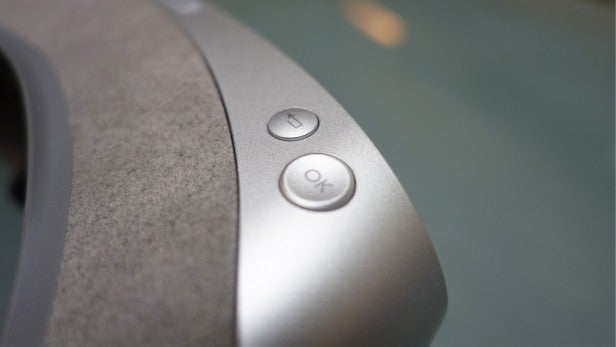
A 3.5mm jack can be found on the bottom left of the visor, but you also have the option of plugging headphones into the phone itself. LG doesn’t provide any headphones with the headset, so you’ll need your own.
The adjustable lenses, which come with two lens covers, can be refocused and moved horizontally in order to get them to line up with your eyes properly. Unfortunately, you won’t be able to wear glasses while using the 360 VR.
In essence, LG’s headset isn’t something you’d want to wear in public, and when you consider that one of the benefits of a mobile headset is that you’re not tethered to an expensive gaming rig, LG really should have put in more effort when it comes to the 360 VR’s design. If we’re going to become a nation of VR zombies with headsets perpetually strapped to our skulls, then can we at least have units that let us to do it in style?
And just to make matters worse, the front of the headset is also home to a picture of a weird, smug-looking cat that appears to be laughing at you.
Related: Oculus Rift vs HTC Vive
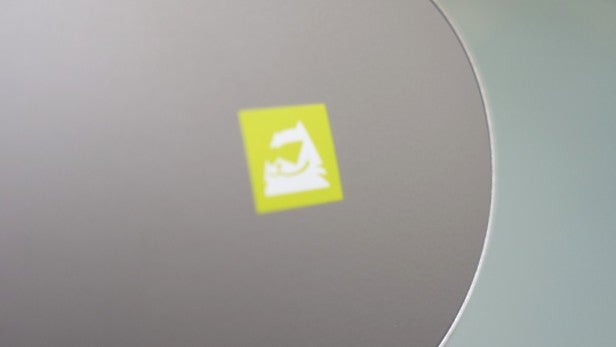
LG 360 VR – Setup
So, how do you go about preparing this engineering oddity for use? Well, you should probably start by ensuring that you’ve been sold a headset that actually works. The first model we received featured a screen that barely managed a single flicker before it refused to work again. Luckily, the second headset we were sent worked without issue.
At least, it worked in the sense that it didn’t malfunction. But I can’t really say I managed to set it up without issue.
In order to use the 360 VR, you have to first download a series of services onto your phone, including the LG Friends Manager, 360 VR Manager, and vrChannel for downloading apps. Once these are installed, it’s simply a matter of plugging the headset into the USB Type-C port on the bottom of the G5; the 360 VR’s screen will automatically come to life once you put on the headset, thanks to a built-in sensor that can detect when you’re wearing the device. So far, pretty straightforward.
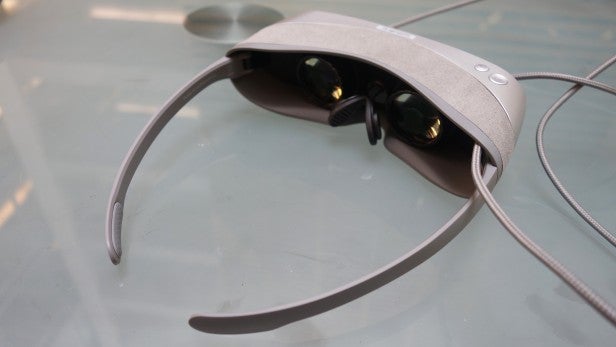
However, that disconcertingly flimsy “light shield”, which blocks very little light, does a superb job hindering your adjustment of the lenses.
Surely it’s simply a case of removing the shield and adjusting the lenses, I hear you say. Not so. Once you’ve been through the laborious task of removing the shield, adjusting the lenses, and refitting the shield, you’ll discover that the lenses have been knocked around during the process, making any alterations a waste of time.
So instead, you’re left trying to space and refocus the lenses with the light shield in place – and this is no easy task. You have to slide your fingers between the headset and your face and awkwardly tap at the lenses until they’re more comfortable to look through.
No matter how much I fiddled with the lenses, I couldn’t get them fully focused to a point my eyes were comfortable. Not only that; the horizontal adjustment is fairly limited, and even after having played around with various alignments for at least five minutes or so, I never really managed to achieve a sharp enough image.
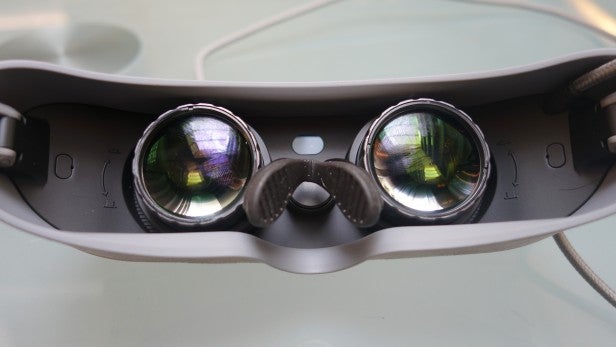
So if, after having handed over you cash, you get to a point where you have a working device and find a comfortable setup, all I can say is “well played”. Now you’ll be able to begin using the one app that comes with the LG 360 VR.
LG 360 VR – Software
Should you find you can tolerate the setup process, you’ll be ready to dive into the wealth of VR content out there. It’s just that none of it is available for the 360 VR.
Once I’d downloaded the 360 VR Manager, vrChannel and all the relevant apps within apps, I opened the vrChannel to find it completely empty, displaying a message saying, “No Content Available“. No doubt content will be added in the future, but for now you’re stuck with one app: Jaunt VR.
When it comes to the Gear VR, which was developed in conjunction with Facebook-owned Oculus. you have access to the app-packed Oculus Store, plus a load of Samsung VR apps. You can play games, browse the internet, watch videos, all from within a well-designed and app-rich interface.
By comparison, the 360 VR becomes an even less tempting proposition once you get the screen working properly.
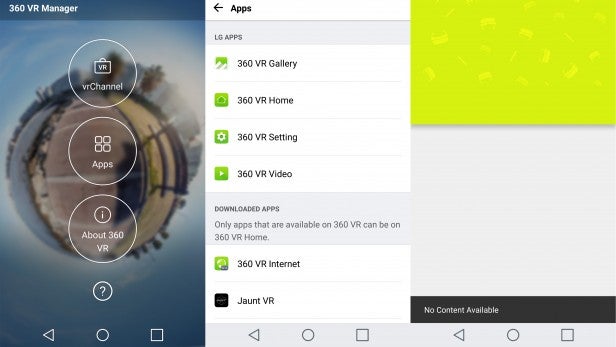
After the setup tutorial, where you’re guided through the various taps and swipes you can use to navigate through the 360 VR software, you’ll be presented with a homescreen that lists several options – from changing settings to loading apps.
As already mentioned, currently there don’t appear to be any apps other than Jaunt VR and the built-in content viewers. However, it seems LG is planning to bring more in the near future; icons for Epic VR, SBS Player, and NextVR are displayed on the 360 VR homescreen but are currently blanked out.
It’s also been reported that you can use the 360 VR with Google Cardboard apps, but just how you do this is a mystery.
Once downloaded, the Cardboard app requests that you choose which cardboard viewer you’re using; it has no options to use the 360 VR. I tried going through the vrChannel app on the phone, which, again, simply displayed the message: “No Content Available”. Perhaps we’ll be enlightened as to how you get Cardboard apps working on the 360 VR in the future, but for now, I remain clueless.
You can view your own content via the 360 VR, whether it be photos or videos. Other than that, however, there isn’t much else on offer.
LG 360 VR – Performance
When you consider that it’s the LG G5 smartphone that’s doing all the heavy-lifting in terms of actually powering the 360 VR’s experiences, you’d at least expect stable performance. The G5 is one of the most powerful handsets on the market, featuring a Snapdragon 820, Adreno 530 GPU and 4GB of RAM. Alas, my own experience with the 360 VR’s performance was disappointing to say the least.
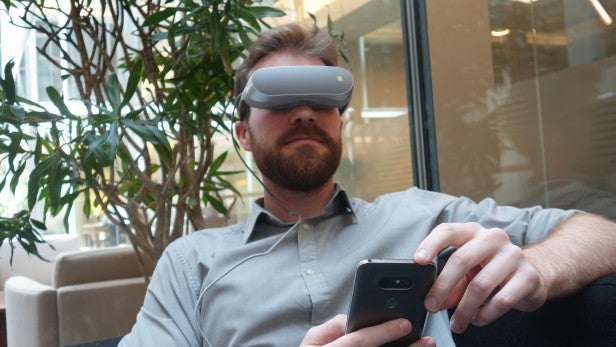
What struck me first upon using the 360 VR headset was the resolution. When testing the HTC Vive, I was surprised by how clearly you could see the individual pixels. I’m not quite sure what I was expecting, but until you’ve tried VR, it isn’t something you give much thought to. Of course, once immersed in the various games and experiences, I quickly became used to the pixellated display.
With a 920 x 720 resolution per eye, the LG 360 VR has a much lower resolution than all other VR headsets on the market. The Oculus Rift and HTC Vive both feature a 1,080 x 1,200 resolution per eye, while the PlayStation VR will arrive with a 960 x 1,080 per-eye setup. Even the Gear VR, which uses the Galaxy S6, S6 Edge, S6 Edge+, Note 5, Galaxy S7, or S7 Edge for its screen, has at least a 1,440 x 1,280 resolution per eye.
However, the 360 VR’s lower pixel count wasn’t as noticeable as I’d feared. Sure, the individual pixels could be seen, but I can honestly say that they weren’t any more noticeable than they are on other headsets I’ve used. Still, the image quality itself wasn’t fantastic.
For those who have tried other VR headsets, another immediate observation will be that the screen appears smaller on the 360 VR. LG says the headset, with its odd 5:4 aspect ratio providing a wider field of view at the top and bottom of the screen, is designed to create the impression of a 130-inch TV viewed from 2m away. This seems a little confusing given that the name of the device is “360 VR”, but fair enough – I gave LG the benefit of the doubt and went forth into the world of LG virtual reality.
The first “experience” was a rollercoaster ride, which comes with the 360 VR as a built-in 360-degree video. To my pleasant surprise, I was transported to the Magic Mountain amusement park in Los Angeles to ride the Twisted Colossus rollercoaster. As a kid I spent several summers in that theme park riding its predecessor, the Classic Colossus, and was pleased that the 360 VR had brought back some childhood memories.
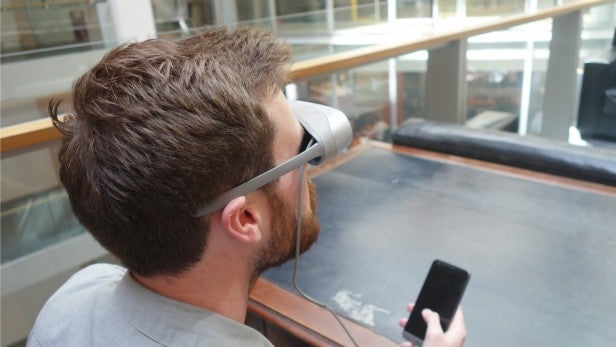
Of course, the nostalgia didn’t last long. Achieving full immersion into any of the VR experiences on the 360 VR is next to impossible, since the light shield’s poor performance keeps you constantly aware of the world around you.
Undeterred, I tried the Jaunt VR app. This is mostly a collection of 360-degree videos, ranging from music videos to tours of exotic locations.
First I loaded up a music video from Ray LaMontagne, which would have been decent if the resolution had gone higher than what appeared to be less than 144p.
The whole experience began to slowly turn nightmarish, as the pixellated shapes shuddered around me in 360 degrees and the distorted face of what I presume was a woman began twisting and contorting before me. Bearing in mind I was using fibre broadband and was around three steps away from the router, the constant pauses as a result of buffering and low resolution seemed puzzling at the very least.
Next, I decided to take a brief trip to Nepal to calm my nerves, but the low resolution here began to make me feel slightly unwell. Note that the images displayed on the 360 VR are also pretty poor in terms of colour reproduction; every 360 video I played looked washed out.
At this point I decided that my first experience with LG’s headset was over.
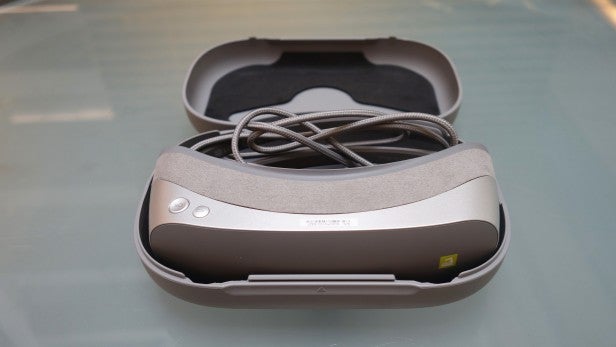
On my first go then, the 360 VR managed to ruin a cherished childhood memory, turn the mellifluous tones of Ray LaMontagne into a waking nightmare, and render the stunning vistas of Nepal completely underwhelming.
I have since tried several other videos and can say that the experience doesn’t get much better. There’s a great video on Jaunt VR called “Remember”, which you can check out here. It looks like it could be very effective on a headset with decent resolution, but on the LG 360 VR it amounted to a disappointing experience once again.
Not content with only providing one main app for use with its VR device, LG also throws some gyroscope issues at you. When using my headset on one occasion, the picture was consistently sliding left out of view. You can re-centre the image by tapping your phone’s screen with two fingers, but having to do so every 20 seconds or so again somehow takes away from the overall virtual-reality experience.
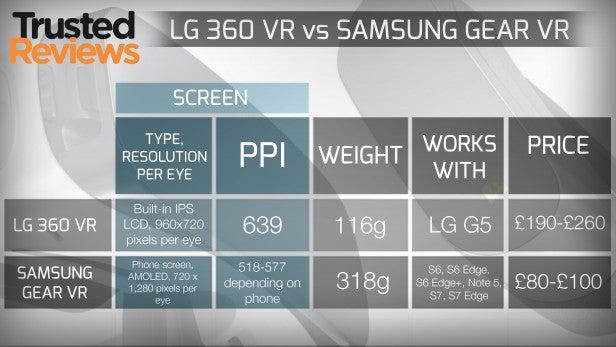
As such, you may often find yourself casting the 360 VR aside in frustration, should you make the decision to hand over £200 for the device in the first place. If the buggy display doesn’t compel you to throw the headset at the wall, the lack of apps certainly will.
Despite the low resolution on the 360 VR not being a huge issue, you’re still paying double what you would for a Gear VR headset, which, although lacking a built-in screen, will always have a better display resolution and won’t let in any light from your surrounding environment.
Add to this an 80-degree horizontal field of view (most headsets have at least 100 degrees, while the Gear VR has 96) and the chances that the 360 VR will enable you to become fully immersed in content – even if there was enough of it to get stuck into – are pretty slim.
I also found that both the phone and the headset itself became uncomfortably warm. The G5 heats up remarkably quickly when the headset is in use, and after taking it off, I noticed that the 360 VR itself had started to warm up on the front of the visor.
Should I buy the LG 360 VR?
In a word – no. Throughout my time with the 360 VR, I couldn’t get over the fact that LG expects you to pay £200 for the privilege. Honestly, I’ve had a much better experience using Google Cardboard, which costs less than £20. In my opinion, even those who already have an LG G5 would achieve a better VR experience by opting for a cardboard viewer instead. Not even a price reduction to £100 would convince me to purchase the LG 360 VR; I’d still choose Google Cardboard over this.
LG 360 VR – Verdict
Flimsy, buggy, uncomfortable, and unsightly – LG’s 360 VR headset seems intent on ruining virtual reality for everyone.
Thanks to mobilefun.co.uk for providing us with the LG 360 VR.

